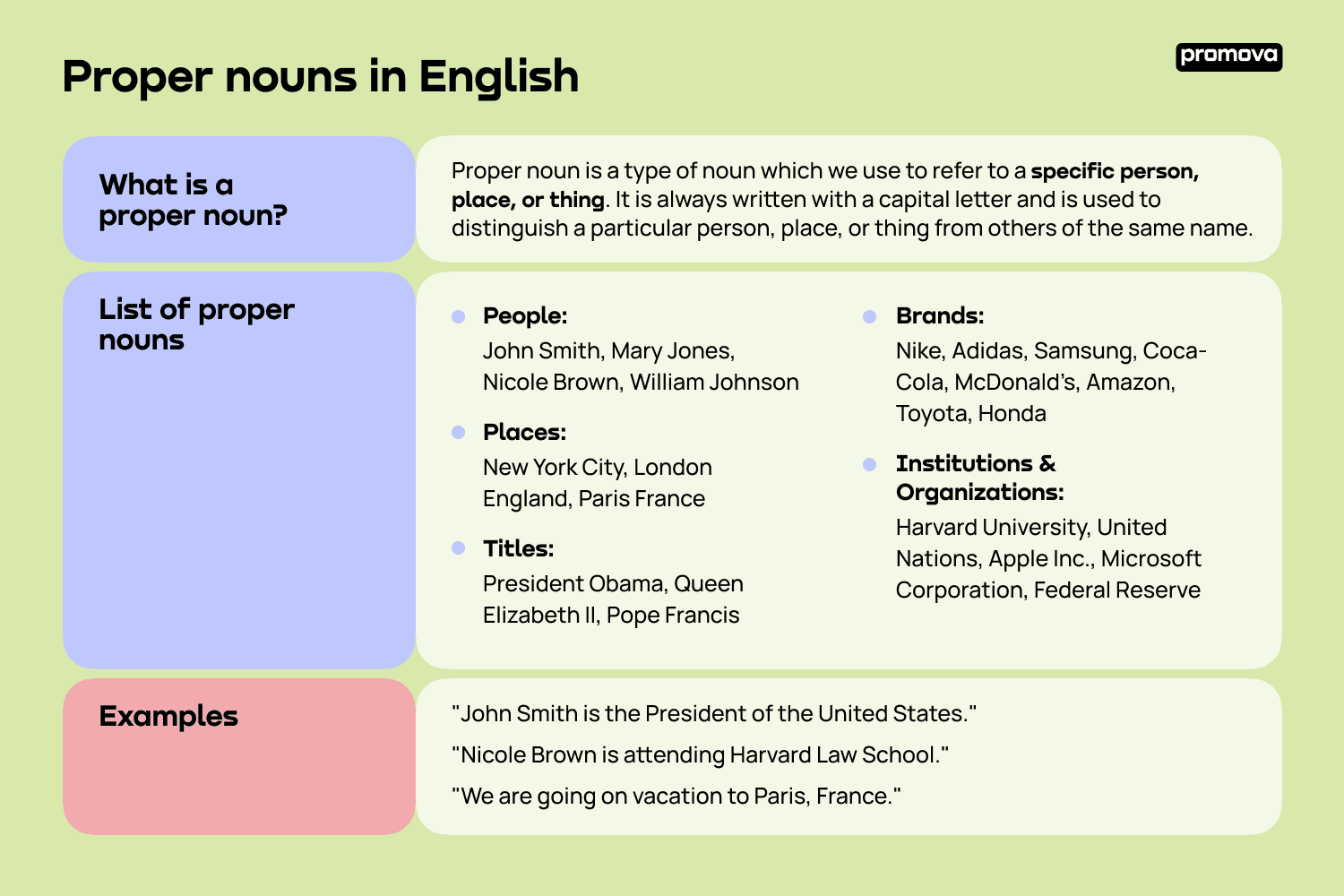Proper nouns in English
Contents
Nouns are a part of speech in the English language and are one of the most commonly used words. In this reference, we'll take a look at what a proper noun is and how you can use it in sentences. We'll also discuss some of the rules that apply to proper nouns. Finally, we'll cover some common mistakes learners make when using proper nouns in English.
What is a proper noun?
Proper noun is a type of noun which we use to refer to a specific person, place, or thing. It is always written with a capital letter and is used to distinguish a particular person, place, or thing from others of the same name. For example, the word "city" is a common noun, while "New York City" is a proper noun because it is referring to a specific city.
Proper nouns can also be used to refer to titles, institutions, and organizations. For example, the word "school" is a common noun, while "Princeton University" is a proper noun because it is referring to a specific school.
They can also refer to specific people, such as "John Smith" or "Nicole Brown." We also use them for specific places, such as "Paris, France" or "San Francisco, California." Finally, specific things and brands are also considered proper, such as "Apple iPhone" or “Lexus.” 
List of proper nouns examples
Below is a list of some common noun types you might encounter:
- People: John Smith, Mary Jones, Nicole Brown, William Johnson, Lisa Miller, Robert Davis, Susan Wilson, Michael Anderson, David Taylor, Sarah White
- Places: New York City, London England, Paris France, Los Angeles California, Tokyo Japan, Sydney Australia, Rome Italy, Berlin Germany
- Institutions and Organizations: Harvard University, United Nations, Apple Inc., Microsoft Corporation, Federal Reserve,
- Titles: President Obama, Queen Elizabeth II, Pope Francis, Prime Minister Trudeau, Governor Cuomo
- Brands: Nike, Adidas, Samsung, Coca-Cola, McDonald’s, Amazon, Toyota, Honda
Proper noun examples in sentences
Proper nouns are used in sentences to refer to specific people, places, titles, institutions, organizations, and things.
Here are some examples of proper nouns in sentences:
- "John Smith is the President of the United States."
- "Nicole Brown is attending Harvard Law School."
- "We are going on vacation to Paris, France."
- "She bought a new Lexus last week."
- “The American Red Cross is helping those in need.”
8
Proper noun rules
All proper nouns must be capitalized. It's extremely important because you might face confusion otherwise. For example, "John Smith" is a proper noun, but "john" is not and is more likely slang for an outhouse.
Finally, proper nouns should not be abbreviated unless the abbreviation is part of the official name. For example, you would write "NASA" instead of "National Aeronautics and Space Administration". Abbreviations are often used in place of the official name by people in the same field.
Whenever a proper noun is followed by a common noun, only the proper noun should be capitalized. For example, you would write "John Smith's house" instead of "john smith's house".
However, sometimes a common noun is part of the proper noun. For example, "Princeton University" is capitalized while a general "university" is not.
Are names proper nouns?
Names are proper nouns because they refer to a specific person. For example, "John Smith" is a proper noun because it refers to a specific person.
In the same way, names of companies, organizations, places, and other entities are also proper nouns. For example, "Apple" is a proper noun because it refers to a specific company. Spelled without capitalization, "apple" will just refer to a fruit.
Summary
Proper nouns are one of the easier concepts to learn in the English language and refer to specific people, places, titles, institutions, organizations, and things. Knowing when to use proper nouns and how to use them can help you not make mistakes in both formal and informal writing.
Comments